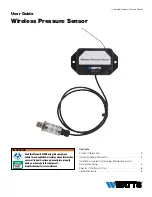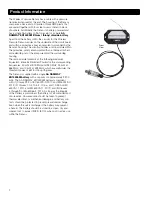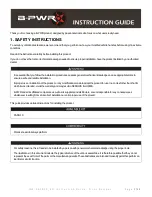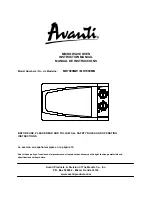
2
Product Information
The Wireless Pressure Sensor has a cable with a pressure
transducer disposed at the end . The housing of the Sensor
comprises a base and a lid made of black ABS plastic that
are sealed together with four steel screws coated in black
phosphate . Additionally, the Sensor is battery-powered and
has a single AA-battery coffin for receipt of a single
AA
RAMWAY ER14505M lithium / thionyl chloride battery
.
Apart from the battery coffin, the circuitry for the Wireless
Pressure Sensor resides on the underside of the circuit board
and within a protective epoxy encapsulant surrounded by the
Sensor’s housing . The circuitry includes a radio module within
the protective, safety encapsulant with an antenna attached
and extending out of the encapsulant and the surrounding
housing .
The radio module transmits at the following maximum
Equivalent, Isometric Radiated Powers for the corresponding
frequencies: 50 mW at 900 MHz and 940 MHz; 25 mW at
868 MHz; and 10 mW at 433 MHz, which are well under the
threshold power of 6W for Group IIA gases .
The Sensor is supplied with a single
AA RAMWAY
ER14505M battery
with a capacity of approximately 2,200
mAh . The AA RAMWAY ER14505M battery is compliant
with: (1) Clause 23 .2 of IEC 60079-0: 2011 and EN 60079-0:
2012; (2) Clauses 10 .4, 10 .5 .2, 10 .5 .a, and 10 .5 .3b of IEC
60079-11 2011 and EN 60079-11: 2012; and (3) Clauses
5 through 9 of EN-60086-4: 2015 . As long as the integrity
of the battery is maintained, the battery is self-contained and
non-reactive . However, care should be taken to prevent
thermal, electrical, or mechanical damage, and battery con-
tacts should be protected to prevent premature discharge .
Even when the cell is discharged, the battery may present
a hazard . The battery should be stored in a clean, dry envi-
ronment not to exceed 303°K (30°C), when not in active use
within the Sensor .
Front
View


























